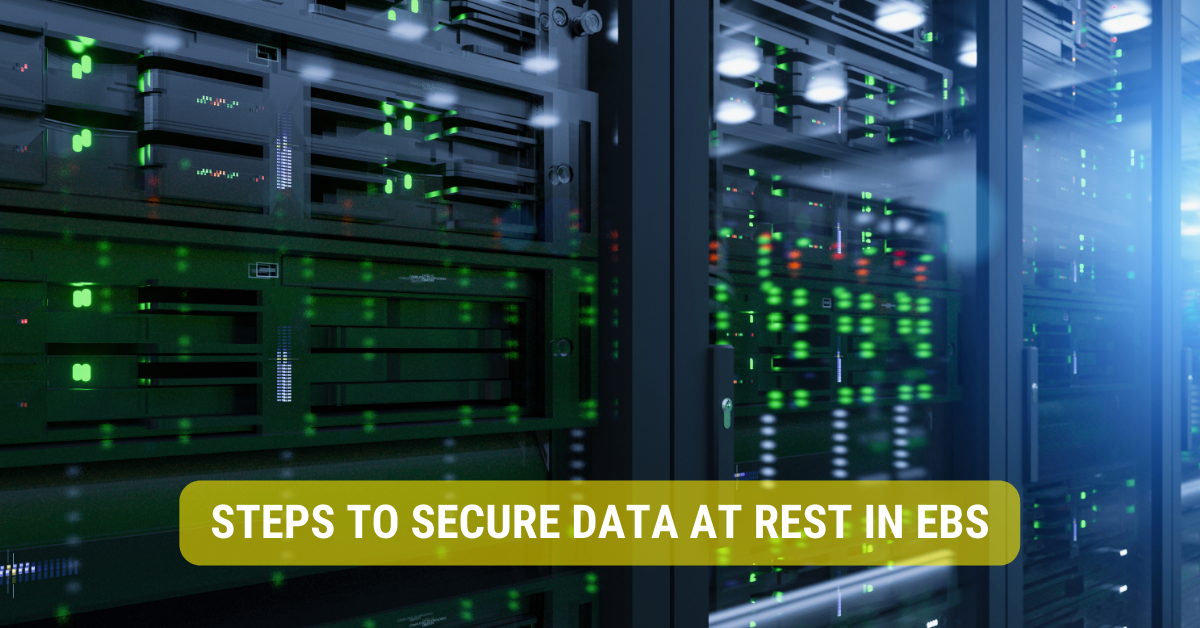Securing data at rest in Amazon Elastic Block Store (EBS) involves several steps:
- Enable EBS encryption: This is a simple setting for creating a new EBS volume. This uses AWS Key Management Service (KMS) to handle the encryption keys.
- Use AWS Identity and Access Management (IAM) policies: Restrict who can access and perform actions on your EBS volumes using IAM policies.
- Regularly snapshot your EBS volumes: This helps in disaster recovery and investigations in case of a breach.
- Monitor with AWS CloudTrail: Use CloudTrail to monitor API call activities for signs of irregular or unauthorized activities.
- Patch and update regularly: Ensure that the EC2 instances associated with your EBS volumes are always up-to-date with the latest security patches.
Data security is a critical concern for any organization that deals with sensitive information. One aspect of data security is securing data at rest, especially in the Amazon Elastic Block Store (EBS) context. In this article, we will explore the various aspects of securing data at rest in EBS and discuss best practices for ensuring the confidentiality and integrity of your data.
Understanding Data at Rest in EBS
Before we delve into securing data at rest in EBS, let’s first understand what we mean by “data at rest.” Data at rest refers to data that is stored and remains dormant in a storage medium, such as EBS volumes, without being accessed or actively used by applications or users.
Securing data at rest is crucial because even though it may not be in transit or actively processed, it can still be vulnerable to unauthorized access, theft, or tampering. By implementing robust security measures, you can mitigate these risks and ensure the safety of your data.
What is Data at Rest?
Data at rest can encompass various data types, including files, databases, backups, and archives. This data is typically stored on persistent devices, such as hard disk drives (HDDs) or solid-state drives (SSDs), commonly used in EBS volumes.
While data at rest may seem dormant, it is not entirely inactive. It is often subject to administrative tasks, backup operations, or system maintenance. Therefore, protecting data at rest becomes paramount to maintaining sensitive information’s confidentiality and integrity.
For example, consider a scenario where a company stores its customer database on an EBS volume. Although users may not actively access the data, it still holds valuable information, such as names, addresses, and payment details. This data could be susceptible to unauthorized access or theft without proper security measures.
Importance of Securing Data at Rest
The importance of securing data at rest cannot be overstated. It is a fundamental aspect of data security and is critical for compliance with various regulatory requirements, such as HIPAA or GDPR. Securing data at rest protects your organization from data breaches, unauthorized access, loss, and potential legal issues.
Furthermore, securing data at rest goes beyond mere compliance. It is an essential component of building trust and maintaining a positive reputation. When customers, partners, and stakeholders know that their data is protected even when it is not actively used, they feel more confident engaging with your organization.
Let’s consider an example illustrating the importance of securing data at rest. Imagine a financial institution that stores its transaction history on EBS volumes. This data contains sensitive information, such as account numbers and transaction details. If this data were compromised, it could lead to financial losses, reputational damage, and even legal consequences.
By implementing encryption, access controls, and regular security audits, the financial institution can ensure that the data at rest remains secure. This protects the institution and its customers and demonstrates a data privacy and security commitment.
Overview of Amazon EBS
Before exploring how to secure data at rest in EBS, let’s briefly understand what Amazon Elastic Block Store (EBS) is and its key features.
Amazon Elastic Block Store (EBS) is a scalable block storage service provided by Amazon Web Services (AWS). It allows you to create persistent block-level storage volumes and attach them to Amazon Elastic Compute Cloud (EC2) instances.
EBS volumes provide durable and reliable storage for your data and are designed to be highly available and fault-tolerant. They offer consistent performance and low-latency access, making them well-suited for various applications, such as databases, file storage, and analytics.
Creating an EBS volume automatically replicates within an Availability Zone (AZ) to provide data durability. This replication ensures that even if a single component fails, your data remains intact and accessible.
Understanding the key features of Amazon EBS is crucial to effectively utilizing this powerful storage service. Let’s delve deeper into the security measures provided by EBS to protect your data at rest.
Key Features of Amazon EBS
Amazon EBS offers several key features that enhance data security and reliability:
- Data Encryption: EBS supports encryption at rest using AWS Key Management Service (KMS) or customer-managed keys. This ensures that your data remains encrypted and protected from unauthorized access.
- Access Control: EBS provides fine-grained access control through AWS Identity and Access Management (IAM) policies. You can define who can create, modify, and delete EBS volumes, ensuring that only authorized users can access your data.
- Monitoring and Logging: EBS integrates with Amazon CloudWatch, allowing you to monitor the performance and health of your volumes. You can set up alarms to notify you of any unexpected changes or issues, ensuring proactive management of your EBS resources.
- Snapshotting: EBS supports point-in-time snapshots, incremental backups of your volumes. These snapshots can restore data or create new volumes, providing additional data protection.
By leveraging these key features, you can enhance the security and reliability of your data stored in Amazon EBS.
Understanding EBS Security
EBS takes security seriously and provides built-in security measures to protect your data at rest. These measures include encryption, access control, and monitoring.
Encryption at rest ensures that your data is protected from unauthorized access, even if the underlying physical storage media is compromised. EBS supports encryption using AWS Key Management Service (KMS) or customer-managed keys, giving you full control over the encryption process.
Access control lets you define who can access and manage your EBS volumes. By utilizing AWS Identity and Access Management (IAM) policies, you can restrict access to specific users or roles, ensuring that only authorized individuals can interact with your data.
Monitoring and logging play a crucial role in maintaining the security of your EBS volumes. By integrating with Amazon CloudWatch, EBS provides detailed metrics and logs that allow you to monitor the performance and health of your volumes. This lets you detect any unusual activity or potential security breaches in real time.
To ensure the security of your data at rest in EBS, it is essential to understand these security features and implement them effectively. You can safeguard your data and meet compliance requirements by leveraging encryption, access control, and monitoring.
Steps to Secure Data at Rest in EBS

Now that we understand data at rest and Amazon EBS, let’s discuss the steps you can take to secure your data at rest in EBS.
Securing your data at rest in Amazon Elastic Block Store (EBS) is of utmost importance to ensure the confidentiality and integrity of your sensitive information. You can protect your data from unauthorized access and potential breaches by implementing a comprehensive security strategy.
1. Configuring Access Control
Access control is a fundamental aspect of securing data at rest. By implementing appropriate access controls, you can restrict unauthorized access to your EBS volumes and prevent data breaches.
In EBS, you can use AWS Identity and Access Management (IAM) roles and policies to control who can access your EBS resources. By defining granular permissions, you can ensure only authorized users and systems can interact with your data.
Furthermore, you can leverage AWS Security Groups to control inbound and outbound traffic to your EBS volumes. By configuring strict rules, you can limit access to only trusted sources, reducing the risk of unauthorized data access.
2. Implementing Encryption
Encryption plays a crucial role in securing data at rest. Encrypting your EBS volumes protects your data, even if unauthorized individuals gain access to physical storage devices.
EBS provides two methods of encryption: Amazon EBS encryption and AWS Key Management Service (KMS) encryption. With EBS encryption, data is encrypted using Amazon-managed keys. KMS encryption allows you to use your encryption keys for added control and flexibility.
When implementing encryption, it is essential to consider the encryption algorithms and key management practices. Choosing strong encryption algorithms and regularly rotating encryption keys are vital to maintaining the security of your data.
3. Regularly Updating and Patching
Regularly updating and patching your EBS volumes is another essential step in securing data at rest. Keeping your volumes up to date ensures that known vulnerabilities are addressed, and fixes are applied promptly.
AWS provides tools and services, such as AWS Systems Manager Patch Manager and AWS Marketplace, which can help you automate updating and patching your EBS volumes. These tools allow you to schedule updates, track compliance, and protect your volumes against emerging threats.
Additionally, it is crucial to stay informed about security advisories and best practices provided by AWS. By regularly monitoring AWS security bulletins and participating in security forums, you can stay proactive in addressing potential vulnerabilities.
Remember, securing data at rest is an ongoing process that requires continuous efforts to stay ahead of potential threats. By following these steps and implementing a robust security strategy, you can ensure your data’s confidentiality, integrity, and availability in EBS.
Best Practices for EBS Data Security
In addition to the specific steps mentioned above, here are some best practices to enhance the security of your data at rest in EBS:
Using IAM Roles and Policies

Implementing least-privilege access and defining fine-grained permissions using IAM roles and policies can minimize the risk of unauthorized access and privilege escalation.
Monitoring with CloudWatch
Monitoring your EBS volumes using Amazon CloudWatch enables you to detect and respond to security-related anomalies or events effectively. You can proactively mitigate potential security threats by setting appropriate alarms and notifications.
Regular Audits and Compliance Checks
Regularly conducting audits and compliance checks is crucial to ensure that your data at rest in EBS adheres to industry standards and regulatory requirements. These audits can help identify any security gaps or non-compliance issues, allowing you to take remedial actions promptly.
Case Studies of EBS Data Security
Let’s now look at some examples of successful implementations and learn from data breaches in the context of EBS data security.
Successful Implementations
Several organizations have successfully implemented robust security measures to protect their data at rest in EBS. These measures include access control policies, encryption, and regular monitoring. By adopting these best practices, organizations can trust that their data is secure.
Lessons Learned from Data Breaches

Unfortunately, data breaches can occur even with the best security measures in place. It is essential to understand the lessons learned from such incidents and take steps to prevent similar breaches in the future. Regular vulnerability assessments, incident response plans, and employee education are vital for maintaining data security.
Key Takeaways
- AWS offers built-in encryption for securing data at rest in EBS.
- Implementing access controls and auditing logs can further enhance security.
- Encryption makes data unreadable to unauthorized users, thus securing it.
Remember to incorporate the relevant keywords in your content to optimize for SEO. For example, for the first topic, you could use keywords like “bank data encryption”, “SSL/TLS protocol”, “AES”, “RSA”, and “ECC”. For the second topic, keywords could include “big data,” “cyber security,” “predictive analysis,” “real-time monitoring,” and “threat detection.”
FAQs
What steps can be taken to secure data at rest in EBS?
Data at rest in EBS can be secured using AWS’s built-in encryption mechanisms. You can also implement access controls and regularly audit access logs to identify unusual activity.
How does encryption help secure data at rest in EBS?
Encryption converts readable data into unreadable text to protect it from unauthorized access. Only those with the correct encryption key can decrypt and access the data.
Conclusion
In conclusion, securing data at rest in Amazon EBS requires a comprehensive approach that combines access control, encryption, updates, and best practices. By implementing these measures, organizations can significantly enhance the security and integrity of their data, instilling trust among stakeholders and protecting themselves from potential data breaches.
